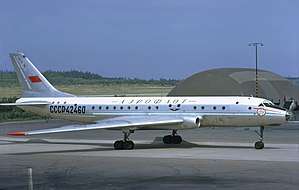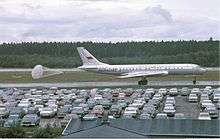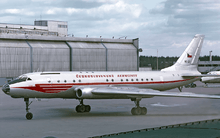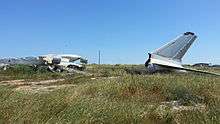Tupolev Tu-104
| Tu-104 | |
|---|---|
 | |
| Aeroflot Tupolev Tu-104B at Arlanda Airport in 1972 | |
| Role | Narrow-body jet airliner |
| Manufacturer | Tupolev OKB |
| Designer | Andrei Tupolev |
| First flight | 17 June 1955 |
| Introduction | 15 September 1956 (Aeroflot) |
| Retired | 1981 |
| Status | Retired |
| Primary users | Aeroflot ČSA |
| Produced | 1956–1960 |
| Number built | 201 |
| Developed from | Tupolev Tu-16 |
| Variants | Tupolev Tu-110 Tupolev Tu-124 |

The Tupolev Tu-104 (NATO reporting name: Camel) was a twinjet medium-range narrow-body turbojet-powered Soviet airliner. It was the second to enter in regular service, behind the British de Havilland Comet, and was the sole jetliner operating in the world from 1956 to 1958, when the British jetliner was grounded due to safety matters.[1]
In 1957, Czechoslovak Airlines – ČSA, (now Czech Airlines) became the first airline in the world to fly a route exclusively with jet airliners, using the Tu-104A variant between Prague and Moscow. In civil service, the Tu-104 carried over 90 million passengers with Aeroflot (then the world's largest airline), and a lesser number with ČSA, while it also saw operation with the Soviet Air Force. Its successors included the Tu-124 (one of the first turbofan-powered airliners), the Tu-134 and the Tu-154.
Design and development
At the beginning of the 1950s, the Soviet Union's Aeroflot airline needed a modern airliner with better capacity and performance than the piston-engined aircraft then in operation. The design request was filled by the Tupolev OKB, which based their new airliner on its Tu-16 'Badger' strategic bomber. The wings, engines, and tail surfaces of the Tu-16 were retained with the airliner, but the new design adopted a wider, pressurised fuselage designed to accommodate 50 passengers. The prototype build in MMZ 'Opit' first flew on June 17, 1955 with Yu.L. Alasheyev at the control. It was fitted with a drag parachute to shorten the landing distance by up to 400 metres (1,300 ft), since at the time not many airports had sufficiently long runways.[1]
Although a popular story says Westerners were surprised by the arrival of the Tu-104 in London during a 1956 state visit by Nikolai Bulganin and Nikita Khrushchev, the airplane had already been revealed at the July 1955 Tushino airshow.[2]
The Tu-104 was powered by two Mikulin AM-3 turbojets placed at the wing roots (remotely resembling the solution used on the de Havilland Comet). The crew consisted of five people: two pilots, a navigator (placed in the glazed "bomber" nose), a flight engineer and a radio operator (the radio operator was later eliminated). The airplane raised great curiosity by its lavish "Victorian" interior – called so by some Western-hemisphere observers – due to the materials used: mahogany, copper and lace.[1]
Tu-104 pilots were trained on the Il-28 bomber, followed by mail flights on an unarmed Tu-16 bomber painted in Aeroflot colors, between Moscow and Sverdlovsk. Pilots with previous Tu-16 experience transitioned into the Tu-104 with relative ease. The Tu-104 was considered difficult to fly, as it was heavy on controls and quite fast on final approach, and at low speeds it would display a tendency to stall, a feature common with highly-swept wings. Experience with the Tu-104 led the Tupolev Design Bureau to develop the world's first turbofan series-built airliner, the Tupolev Tu-124, designed for local markets, and subsequently the more commercially successful Tu-134
Operational history
On September 15, 1956, the Tu-104 began revenue service on Aeroflot's Moscow-Omsk-Irkutsk route, replacing the piston-engined Ilyushin Il-14. The flight time was reduced from 13 hours and 50 minutes to 7 hours and 40 minutes, and the new jet dramatically increased the level of passenger comfort.[1] By 1957, Aeroflot had placed the Tu-104 in service on routes from Vnukovo Airport in Moscow to London, Budapest, Copenhagen, Beijing, Brussels, Ottawa, Delhi, and Prague.
In 1957, ČSA Czechoslovak Airlines became the only export customer for the Tu-104, placing the aircraft on routes to Moscow, Paris and Brussels. ČSA bought six Tu-104As (four new and two used examples) configured for 81 passengers. Three of these aircraft were subsequently written off (one due to a refuelling incident in India and another to a pilot error without fatalities).[1]
In 1959, the plane was leased to Sir Henry Lunn Ltd. (Lunn Poly) of London which used the plane for 12 holidays to Russia and boasted a 4.5 hours flight time.
The Tu-104 continued to be used by Aeroflot throughout the 1960s and 1970s. Some 16 aircraft were lost in crashes. The safety record of the plane was very poor, but comparable to other jet airliners of its day. Tu-104 was unreliable, heavy, very unstable and poorly controlled in flight, it was inclined to swing (the Dutch roll). Weak mechanization of the wing facilitated stalling at low speeds. Due to the design features of the aircraft, the glide path was not maintained, the speed was extinguished by a stepwise decrease. The recommended landing speed of 225-250 km/h was never observed, and often the aircraft was planted at 270-300 km/h. A special danger was "pick-up". The plane picked up abruptly, it instantly gained a big height, and then broke into an uncontrolled vertical dive. At least 2 catastrophes occurred for this reason. Later, the design of the aircraft and the operating instructions were changed, but the problem still remained. Aeroflot retired the Tu-104 from civil service in March 1979 following a fatal accident at Moscow. Following this, several aircraft were transferred to the Soviet military, which used them as staff transports and to train cosmonauts in zero gravity. However, after a Tu-104 crash in February 1981 killed 52 people (17 of whom were senior army and naval staff), the type was permanently removed from service. The last flight of the Tu-104 was a ferry flight to Ulyanovsk Aircraft Museum in 1986.
Variants
Data from: [1]
- Tu-104 – initial version seating 50 passengers. It used two Mikulin AM-3 turbojet engines, each with 6,735 kg of thrust. 29 airframes were built.
- Tu-104 2NK-8 – Proposed version powered by two Kuznetsov NK-8 turbofan engines.
- Tu-104A – Improved version appearing in June 1957; continued improvements of the Mikulin engines (Mikulin AM-3M each with 8,700 kg of thrust) permitted significant growth in capacity, resulting in a 70-seater variant. The Tu-104A became the definitive production variant. On September 6, 1957, it flew with 20 t of payload at 11,211 m of altitude. On September 24, 1957, it reached 970.8 km/h average speed with a two tonne payload. A total of 80 airframes were built, of which six were exported to Czechoslovakia.
- Tu-104AK – testbed aircraft for Zero-G cosmonauts' training and testing the Soviet space programme equipment
- Tu-104A-TS – Five Tu-104A's converted to freighter/medevac aircraft.
- Tu-104B – Further improvements made by stretching fuselage 1.2 meters and fitting new Mikulin AM-3M-500 turbojets (9,700 kg of thrust each). The Tu-104B was able to accommodate 100 passengers. This variant took advantage of the newer fuselage from the Tu-110 and the existing wings. It began revenue service with Aeroflot on April 15, 1959 on the Moscow-Saint Petersburg route. A total of 95 airframes were built. Most were later rebuilt to Tu-104V-115 standard.
- Tu-104B-TS – Six Tu-104B's converted to freighter/medevac aircraft.
- Tu-104D – VIP version with two sleeper cabins forward and a 39-seat cabin aft.
- Tu-104D-85 – Tu-104A airframes rebuilt to accommodate 85 passengers.
- Tu-104D 3NK-8 – Project powered by three NK-8 engines, precursor of Tu-154.
- Tu-104E – A higher performance Tu-104 powered by RD-16-15 engines giving better fuel economy as well as higher thrust. Two prototypes were converted from Tu-104B's CCCP-42441 and CCCP-42443, but the program was cancelled in the mid-1960s in favor of the Tu-154.
- Tu-104G – VIP version for the Federal government with two VIP cabins forward and a 54-seat cabin aft.
- Tu-104LL – Several serial numbers converted for use in testing Tu-129, Tu-22M electronics, and air-to-air missile systems (including launch).
- Tu-104SH – Navigator trainer in two versions
- Tu-104V – The first use of this designation was for a projected 117 seat medium haul version with six-abreast seating. Project cancelled.
- Tu-104V – The second use of this designation was used for Tu-104A airframes rebuilt to accommodate 100/105 passengers. A later version packed 115 passengers in by reducing seat pitch and adding seat rows.
- Tu-104V-115 – Tu-104B airframes rebuilt to accommodate 115 passengers, with new radio and navigational equipment.
- Tu-107 – Proposed military transport version with rear loading ramp and defensive turret armed with paired cannon. One prototype built; project cancelled
- Tu-110 – Four-engined version intended for export. A number of prototypes were built; project cancelled.
- Tu-118 – A projected turboprop freighter version powered by four Kuznetsov TV-2F engines.
Former operators

- CSA Czechoslovak Airlines – Six aircraft.
- Czechoslovakian Air Force
Accidents and incidents
According to the American Flight Safety Foundation, between 1958 and 1981, 16 Tu-104s were lost in crashes out of 37 aircraft written off (hull loss rate = 18%) with a total of 1140 fatalities.[3]
| Date | Tail number | Aircraft type | Location | Casualties | Description | Refs |
|---|---|---|---|---|---|---|
| 19 February 1958 | CCCP-Л5414 | Tu-104 | 0/3 | Force-landed short of the runway after running out of fuel following a diversion. | [4] | |
| 15 August 1958 | CCCP-Л5442 | Tu-104A | 64/64 | Aeroflot Flight 4 stalled, spun down and crashed after entering an updraft at 12,000 m (39,000 ft). | [5][6] | |
| 17 October 1958 | CCCP-42362 | Tu-104A | 80/80 | A flight carrying high-level delegations crashed when it entered a dive and crashed after entering an updraft at 12,000 m (39,000 ft). The Tu-104 was limited to 9,000 m (30,000 ft) and the tail modified in the wake of this accident. | [7] | |
| 20 October 1960 | CCCP-42452 | Tu-104A | 3/68 | Aeroflot Flight 5 struck sloping terrain and crashed while the pilot was checking the landing lights. | [8][9] | |
| 1 February 1961 | CCCP-42357 | Tu-104A | 0 | Overran runway after landing too late. | [10] | |
| 16 March 1961 | CCCP-42438 | Tu-104B | 7/51 | Aeroflot Flight 68 force-landed on a frozen pond following double engine failure. Two people on the ground also died when a house was struck by the aircraft. | [11][12] | |
| 10 July 1961 | CCCP-42447 | Tu-104B | 1/94 | Aeroflot Flight 381 crashed after entering downdrafts while landing in bad weather. | [13][14] | |
| 17 September 1961 | CCCP-42388 | Tu-104A | 0 | Heavy landing; written off. | [15] | |
| 2 November 1961 | CCCP-42504 | Tu-104B | 0 | Struck a radio antenna while on approach and force-landed in a field following engine failure. | [16] | |
| 4 June 1962 | CCCP-42491 | Tu-104B | 5/5 | Struck a mountain following engine failure. | [17] | |
| 30 June 1962 | CCCP-42370 | Tu-104A | 84/84 | Aeroflot Flight 902 crashed after it was accidentally shot down by a missile. | [18] | |
| 3 September 1962 | CCCP-42366 | Tu-104A | 86/86 | Aeroflot Flight 3 lost control at 4,500 m (14,800 ft) while climbing. Although the cause was not determined, issues with the autopilot were blamed. An accidental shoot-down by a missile was also theorized. | [19][20] | |
| 25 October 1962 | CCCP-42495 | Tu-104B | 11/11 | Crashed on takeoff during a test flight due to cross-connected rudder controls. | [21] | |
| 16 March 1963 | OK-LDB | Tu-104A | Unknown | Caught fire while being refueled. | [22] | |
| 18 May 1963 | CCCP-42483 | Tu-104B | 0 | Stalled on approach and crashed. | [23] | |
| 13 July 1963 | CCCP-42492 | Tu-104B | 33/35 | Aeroflot Flight 12 crashed short of the runway due to incorrect instrument readings. Water entered the instrument wiring, causing a short circuit. | [24][25] | |
| 9 June 1964 | CCCP-42476 | Tu-104B | Unknown | Overshot runway in heavy rain during second landing attempt. | [26] | |
| 28 April 1969 | CCCP-42436 | Tu-104B | Unknown | Landed 600 m (2,000 ft) short of runway; written off. | [27] | |
| 1 June 1970 | OK-NDD | Tu-104A | 13/13 | Crashed short of the runway after the pilot attempted an approach to runway 36. | [28] | |
| 25 July 1971 | CCCP-42405 | Tu-104B | 97/126 | Aeroflot Flight 1912 landed 150 m (490 ft) short of the runway; breaking off the left wing. The aircraft rolled to the left and caught fire. | [29][30] | |
| 10 October 1971 | CCCP-42490 | Tu-104B | 25/25 | Aeroflot Flight 773 crashed shortly after takeoff after an explosion occurred while climbing through 1,200 m (3,900 ft). The explosion damaged the fuselage and destroyed flight controls. Control was lost and the aircraft rolled right and entered a descent until it struck the ground. The explosion was caused by a bomb placed between the cabin wall and a passenger seat in the rear of the cabin near frame 45. | [31][32] | |
| 19 March 1972 | CCCP-42408 | Tu-104B | 0 | Struck a snow wall short of the runway during the fifth landing attempt. | [33] | |
| 24 April 1973 | CCCP-42505 | Tu-104B | 2/57 | Hijacked by a passenger who demanded to be taken to Sweden. The crew returned to Leningrad. While the landing gear was lowered, the hijacker set off a bomb, killing himself and the flight engineer. The bomb blew a hole in the fuselage, but the aircraft was able to land safely. | [34][35] | |
| 18 May 1973 | СССР-42379 | Tu-104B | 82/82 | Aeroflot Flight 109 was hijacked by a passenger who demanded to be taken to China. A bomb that the hijacker had put on board the aircraft detonated at 30,000 ft (9,100 m) and the aircraft lost control and crashed east of Lake Baikal. | [36][37] | |
| 29 August 1973 | OK-MDE | Tu-104A | 0/70 | CSA Flight 531 veered off the runway after landing after the pilot failed to stop the aircraft in time. The wreckage remains at the airport site to this day. | [38] | |
| 30 September 1973 | CCCP-42506 | Tu-104B | 108/108 | Aeroflot Flight 3932 crashed shortly after takeoff due to a power failure of the artificial horizons. | [39] | |
| 13 October 1973 | CCCP-42486 | Tu-104B | 122/122 | Aeroflot Flight 964 crashed while on approach following a power failure to the compass system and main gyros and resulting loss of control. The crash is the worst involving the Tu-104. | [40] | |
| 7 December 1973 | CCCP-42503 | Tu-104B | 16/75 | Aeroflot Flight 964 crashed after a wing struck the ground after coming in too fast. | [41][42] | |
| 5 November 1974 | CCCP-42501 | Tu-104B | 0 | Overran the runway on landing and came to rest against a railway embankment. | [43] | |
| 30 August 1975 | CCCP-42472 | Tu-104B | 0 | Right landing gear collapsed following a heavy landing. | [44] | |
| 9 February 1976 | CCCP-42327 | Tu-104A | 24/115 | Aeroflot Flight 3739 crashed after banking to the right while climbing for takeoff and entering a descent. Debris from the aircraft struck a North Korean Tu-154 that had just landed. Although the official cause of the accident was loss of control caused by crosswinds, improper fueling (too much fuel on one side) and pilot error were also theorized. | [45][46] | |
| 17 July 1976 | CCCP-42335 | Tu-104A | 0 | Failed to take off and crashed due to overloading. | [47] | |
| 28 November 1976 | CCCP-42471 | Tu-104B | 72/72 | Aeroflot Flight 2415 lost control and crashed following artificial horizon failure and resulting crew disorientation. | [48][49] | |
| 1976 | CCCP-42371 | Tu-104A | Unknown | Crashed short of the runway after the engines were shut down in flight. | [50] | |
| 13 January 1977 | CCCP-42369 | Tu-104A | 96/96 | Aeroflot Flight 3843 exploded in mid-air due to an engine fire. | [51][52] | |
| 17 March 1979 | CCCP-42444 | Tu-104B | 58/119 | While operating as Aeroflot Flight 1691, the crew encountered a false fire alarm from engine during takeoff and turned back to Vnukovo. The plane crashed while attempting to return to the airport. Aeroflot removed the Tu-104 from service following this accident. | [53] | |
| 7 February 1981 | CCCP-42332 | Tu-104A | 51/51 | Soviet Navy flight; 1981 Pushkin Tu-104 crash, failed to take off due to shifting cargo. All military Tu-104's were grounded following this accident. | [54] |


Specifications (Tu-104B)
Data from Gordon and Rigmant[55][56]
General characteristics
- Crew: seven
- Capacity: 50–115 passengers
- Length: 40.05 m (131 ft 5 in)
- Wingspan: 34.54 m (113 ft 4 in)
- Height: 11.90 m (39 ft 0 in)
- Wing area: 184 m² (1,975 ft²)
- Empty weight: 43,800 kg (96,560 lb)
- Loaded weight: 78,100 kg (172,180 lb)
- Powerplant: 2 × Mikulin AM-3M-500 turbojets, 95.1 kN (21,400 lbf) each
Performance
- Maximum speed: 950 km/h (513 knots, 590 mph)
- Cruise speed: 800 km/h (432 knots, 497 mph)
- Range: 2,750 km (1,485 nm, 1,709 mi)
- Service ceiling: 12,000 m (39,370 ft)
- Rate of climb: 10 m/s (1,969 ft/min)
See also
Related development
Aircraft of comparable role, configuration and era
Related lists
References
- 1 2 3 4 5 6 "Reactores Comerciales (1999a) (en: Commercial Jetliners)". Antonio López Ortega (in Spanish). Agualarga Editores S.l. ISBN 84-95088-87-8. Retrieved 2008-09-26.
- ↑ Analysis of Camel/Tu-104, Central Intelligence Agency, August 3, 1957.
- ↑ Tu 104 statistics
- ↑ Accident description for CCCP-L5414 at the Aviation Safety Network. Retrieved on 2015-12-15.
- ↑ Accident description for CCCP-L5442 at the Aviation Safety Network. Retrieved on 2015-12-15.
- ↑ "Катастрофа Ту-104А МУТА ГВФ в 215 км от а/п Хабаровск" [Accident Tu-104 215 km from Khabarovsk Airport] (in Russian). airdisaster.ru. Retrieved 2015-12-28.
- ↑ Accident description for CCCP-42362 at the Aviation Safety Network. Retrieved on 2015-12-15.
- ↑ Accident description for CCCP-42452 at the Aviation Safety Network. Retrieved on 2015-12-15.
- ↑ "Катастрофа Ту-104А Дальневосточного управления ГВФ близ аэр. Усть-Орда" [Accident Tu-104 near Ust-Orda] (in Russian). airdisaster.ru. Retrieved 2015-12-28.
- ↑ Accident description for CCCP-42357 at the Aviation Safety Network. Retrieved on 2015-12-15.
- ↑ Accident description for CCCP-42438 at the Aviation Safety Network. Retrieved on 2015-12-15.
- ↑ "Катастрофа Ту-104Б ЗС УГВФ в Свердловске" [Accident Tu-104 Sverdlovsk] (in Russian). airdisaster.ru. Retrieved 2015-12-28.
- ↑ Accident description for CCCP-42447 at the Aviation Safety Network. Retrieved on 2015-12-15.
- ↑ "Катастрофа Ту-104Б Северного управления ГВФ в а/п Одессы" [Accident Tu-104 Odessa Airport] (in Russian). airdisaster.ru. Retrieved 2015-12-28.
- ↑ Accident description for CCCP-42388 at the Aviation Safety Network. Retrieved on 2015-12-15.
- ↑ Accident description for CCCP-42504 at the Aviation Safety Network. Retrieved on 2015-12-15.
- ↑ Accident description for CCCP-42491 at the Aviation Safety Network. Retrieved on 2015-12-15.
- ↑ Accident description for CCCP-42370 at the Aviation Safety Network. Retrieved on 2015-12-15.
- ↑ Accident description for CCCP-42366 at the Aviation Safety Network. Retrieved on 2015-12-15.
- ↑ "Катастрофа Ту-104А Дальневосточного управления ГВФ близ Хабаровска" [Accident Tu-104 near Khabarovsk] (in Russian). airdisaster.ru. Retrieved 2015-12-28.
- ↑ Accident description for CCCP-42495 at the Aviation Safety Network. Retrieved on 2015-12-15.
- ↑ Accident description for OK-LDB at the Aviation Safety Network. Retrieved on 2015-12-15.
- ↑ Accident description for CCCP-42483 at the Aviation Safety Network. Retrieved on 2015-12-15.
- ↑ Accident description for CCCP-42492 at the Aviation Safety Network. Retrieved on 2015-12-15.
- ↑ "Катастрофа Ту-104Б Восточно-Сибирского управления ГВФ в районе Иркутска" [Accident Tu-104 near Irkutsk] (in Russian). airdisaster.ru. Retrieved 2015-12-28.
- ↑ Accident description for CCCP-42476 at the Aviation Safety Network. Retrieved on 2015-12-15.
- ↑ Accident description for CCCP-42436 at the Aviation Safety Network. Retrieved on 2015-12-15.
- ↑ Accident description for OK-NDD at the Aviation Safety Network. Retrieved on 2015-12-15.
- ↑ Accident description for CCCP-42405 at the Aviation Safety Network. Retrieved on 2015-12-15.
- ↑ "Катастрофа Ту-104Б Толмачевского ОАО в а/п Иркутс" [Accident Tu-104 Irkutsk Airport] (in Russian). airdisaster.ru. Retrieved 2015-12-28.
- ↑ Criminal description for CCCP-42490 at the Aviation Safety Network. Retrieved on 2015-12-15.
- ↑ "Взрыв на борту Ту-104Б Украинского УГА близ аэропорта Внуково" [Explosion on Tu-104 near Vnukovo] (in Russian). airdisaster.ru. Retrieved 2015-12-28.
- ↑ Accident description for CCCP-42408 at the Aviation Safety Network. Retrieved on 2015-12-15.
- ↑ "Бортовой №: CCCP-42505". Retrieved 11 November 2011.
- ↑ Accident description for CCCP-42505 at the Aviation Safety Network. Retrieved on 2015-12-15.
- ↑ Hijacking description for CCCP-42411 at the Aviation Safety Network. Retrieved on 2015-12-15.
- ↑ "Взрыв на борту и катастрофа Ту-104А Восточно-Сибирского УГА в районе Читы" [Explosion on Tu-104 Chita region] (in Russian). airdisaster.ru. Retrieved 2015-12-28.
- ↑ Accident description for OK-MDE at the Aviation Safety Network. Retrieved on 2015-12-15.
- ↑ Accident description for CCCP-42506 at the Aviation Safety Network. Retrieved on 2015-12-15.
- ↑ Accident description for CCCP-42486 at the Aviation Safety Network. Retrieved on 2015-12-15.
- ↑ Accident description for CCCP-42503 at the Aviation Safety Network. Retrieved on 2015-12-15.
- ↑ "Катастрофа Ту-104Б Грузинского УГА в а/п Домодедово" [Accident Tu-104 Domodedovo Airport] (in Russian). airdisaster.ru. Retrieved 2015-12-28.
- ↑ Accident description for CCCP-42501 at the Aviation Safety Network. Retrieved on 2015-12-15.
- ↑ Accident description for CCCP-42472 at the Aviation Safety Network. Retrieved on 2015-12-15.
- ↑ Accident description for CCCP-42327 at the Aviation Safety Network. Retrieved on 2015-12-15.
- ↑ "Катастрофа Ту-104А ВС УГА в Иркутске" [Accident Tu-104 Irkutsk] (in Russian). airdisaster.ru. Retrieved 2015-12-28.
- ↑ Accident description for CCCP-42335 at the Aviation Safety Network. Retrieved on 2015-12-15.
- ↑ Accident description for CCCP-42471 at the Aviation Safety Network. Retrieved on 2015-12-15.
- ↑ "Катастрофа Ту-104Б Ленинградского ОАО в районе а/п Шереметьево" [Accident Tu-104 Sheremetyevo/Leningrad area] (in Russian). airdisaster.ru. Retrieved 2015-12-28.
- ↑ Accident description for CCCP-42438 at the Aviation Safety Network. Retrieved on 2015-12-15.
- ↑ Accident description for CCCP-42369 at the Aviation Safety Network. Retrieved on 2015-12-15.
- ↑ "Катастрофа Ту-104А Дальневосточного УГА в районе а/п Алма-Ата" [Accident Tu-104 near Alma-Ata Airport] (in Russian). airdisaster.ru. Retrieved 2015-12-28.
- ↑ Accident description for CCCP-42444 at the Aviation Safety Network. Retrieved on 2015-12-15.
- ↑ Accident description for CCCP-42332 at the Aviation Safety Network. Retrieved on 2015-12-15.
- ↑ Yefim Gordon and Vladimir Rigmant Tupolev Tu-104: Aeroflot's first jet; 2007 ; translated by Dimitriy Komissarov; ISBN 978-1-85780-265-8; Midland Publishing / Ian Allen Publishing Ltd, UK
- ↑ http://www.flugzeuginfo.net/acdata_php/acdata_tu104_en.php
http://www.airforce.ru/content/english-pages/2344-interview-civil-aviation-pilot-hsu-v-m-yanchenko/
External links
| Wikimedia Commons has media related to Tupolev Tu-104. |